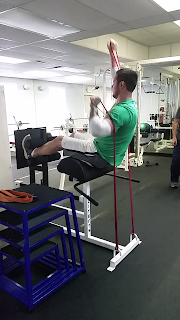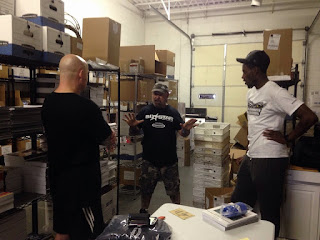 |
Photo courtesy of Fight! Magazine.
|
Shane Carwin was arguably one of the strongest, most powerful fighters in the UFC heavyweight division. Unfortunately a couple of injuries forced him to retire from the sport. Lately I've seen some comments on his social media about a possible comeback!
A monster heavyweight with insane knockout power, Shane is also intelligent and well spoken. I had the pleasure of interviewing him for Fight! Magazine in April of 2010 after his huge KO victory over Frank Mir for the interim heavyweight belt, and meeting him in Vegas shortly after. Unfortunately Fight! never ran the interview, so I thought it would be cool to resurrect it since hearing the news about his possible return.
While this interview is a bit dated and may not reflect Shane's current training program, there are still valuable nuggets of information he shared regarding strength training and conditioning for fighters.
I hope you enjoy this interview and here's hoping we see Shane back in the octagon and dominating the heavyweight division soon!
###
Scott:
Shane, thanks for taking the time to do this interview, I
sincerely appreciate it. It seems that more fighters are placing a
greater emphasis on strength training and conditioning as a means to supplement
their fight training. This is definitely a shift from the idea that
technique mastery is all a fighter needs to be at the top of their game.
What is your opinion on strength and conditioning for the mixed martial arts
athlete?
Shane:
I think it’s absolutely necessary. Everyone talks
about technique now, but everyone is working on technique. People spend a
lot of time studying all these different martial arts and what can really
separate you is a good strength and conditioning program. It’s just like
any other sport; I think MMA is going to evolve a lot faster because all these
other sports had to go through all these growing pains already. Strength and
conditioning coaches already know how to get these athletes to perform at a
higher level, that science is already out there for these fighters to take
advantage of.
Scott:
In a previous interview you said that you trained with
weights three times per week and ran two times per week in addition to four
weekly sessions of jiu jitsu, boxing, Muay Thai, and MMA training. Has
your training changed any since then, and how important is your strength and
conditioning training to your career in the mixed martial arts?
Shane:
It has changed. I still do three times per week as
far as the strength goes and conditioning is still part of that with the
strength, but I get some of the conditioning during sparring and my one-on-one
sessions, which we try to vary up a little bit. Now I have eight
practices a week on top of the strength, three are sparring, some are
wrestling, and some are one-on-one with jiu jitsu or boxing.
Scott:
So by the nature of the sport practice itself you are
finding that there is a benefit in terms of conditioning?
Shane:
When you are going live you are definitely getting some
of the conditioning in that is more appropriate for the sport, such as the
pushing and pulling of the body and other things you’re not going to feel just
by running. Running is still good and definitely helps build endurance in
the legs so I get some of that in there too. A lot of it comes from
practice and some of it comes from me, I feel what my body needs.
Scott:
It seems that athletes always make the greatest gains in
size and strength by following a steady diet of the basic, heavy barbell lifts
such as squats, deadlifts, presses, etc. Do these, or any other lifts,
make up the foundation of your strength training program?
Shane:
Yeah, absolutely. You are not going to get bigger
or stronger without doing those core lifts. There are some other lifts
that you can add for explosiveness. I think the explosive training, along
with the core lifts that you said, is the way to go for fighting – it’s
basically a take-off of other sports.
Scott:
Do you use any
other forms of training like kettlebells or sled work in your strength and
conditioning program?
Shane:
Absolutely, I would say that is a good portion of my
conditioning. I got away from running a little bit because of the
pounding and the shin splints. For conditioning we have had to do more
circuit training that involves pushing the sled, burpees, medicine ball slams,
plyometric pushups and things of that nature.
Scott:
What does a typical training week look like for
you?
Shane:
Monday, Wednesday and Friday are lifting days consisting
of plyometrics, Olympic lifts, strength lifts, as well as some agility
work. My strength and conditioning coach also puts some general physical
preparation (GPP) work in there and some core exercises. This is
typically done around lunchtime. At night I’ll do some one-on-one in
boxing and maybe jiu jitsu or whatever practice I feel I might need, it might
be some wrestling as well. Tuesday and Thursday mornings are sparring and
at night it is usually wrestling or jiu jitsu. Saturday is another
sparring day and Sundays are my off days. I think one of the main
problems with the sport and so many of the injuries is that there is probably
not enough off time because everyone is trying to get all these disciplines
in. It’s not like going out and training football where you train the
same position five to six days per week. When you’re training in boxing, kick
boxing, Muay Thai, wrestling, jiu jitsu, then do your strength and conditioning
work it’s tough to get all that in and be where you need to be. I
definitely think that people can over-train in this sport very easily.
Scott:
Are there any specific restoration and recovery methods
you find beneficial?
Shane:
Yeah, I get some Muscle Activation Technique (MAT) work
done by a guy named Matt Bernier that seems to help me the most. I think
everybody has different things that work for them. I also do contrast
baths. At my house I have an ice bath and a hot tub right next to each
other and I’ll go five in one and five in the other and go back and forth like
that a number of times. I learned that down in Louisiana when I was
training for the NFL in 1998 with strength and conditioning coach Kurt Hester
who was helping Chuck Wiley, Alan Fanaca and myself out.
Scott:
Some people might not realize you went as far as you did
in football being invited to the NFL Scouting Combine and a projected fifth
round pick. Do you ever miss playing football?
Shane:
Absolutely, I love the sport and unfortunately what
happened to me was I bulged three discs and ruptured a disc so at that point I
was damaged goods. You know it is what it is, I loved the game, I still
love the game, and just driving in the fall I can smell that grass and get
those feelings you know.
Scott:
Is nutrition and supplementation important to your
preparation and ability to recover between training sessions?
Shane:
Yeah absolutely, as far as nutrition and supplementation
goes, if you are not fueling your body when you are weight training and
conditioning to me it’s no good without good wholesome whole foods and high
quality sports supplements. Without the fuel your body is not going to
grow.
Scott:
Is there anything you would like to add pertaining to
your strength and conditioning or fight training program that people reading
this may be interested in?
Shane:
It amazes me that some of these fighters are just now
saying they’re hiring strength and conditioning coaches - that’s crazy to
me. I can’t understand how they haven’t been doing strength work the
whole time.
Scott:
It amazes me too. I’ve always maintained that if
you had two athletes, regardless of the sport, with identical skill levels, and
one spent time building strength, power and speed while the other only worked
on technique, the stronger more powerful guy would win every time.
Shane:
Not only is he going to win, he’s going to destroy the
other guy.
Scott:
Unfortunately I think when some fighters think of
strength they picture a huge, super-heavyweight powerlifter who lacks mobility
and some of the other skills necessary for fighters and that’s not the case.
Shane:
No not at all. Another
thing those people are not going to like to hear is that it takes a long time
to develop that strength and power. It’s not done over a period of
months; it’s done over a period of years. You have to stay committed and
dedicated to getting stronger and not expect it to happen overnight.
Scott:
Shane, thank you sincerely for your time, I appreciate it
and wish you the absolute best with your MMA career.
Shane:
Thank you.









